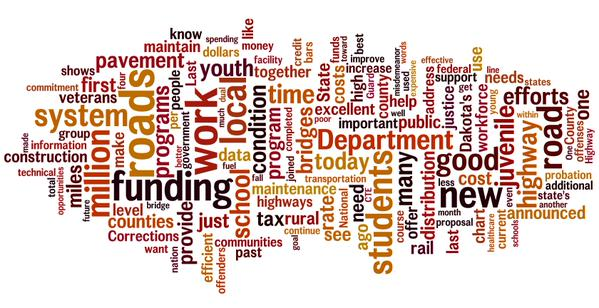by Meghan Thoreau
FACTOID. The Senate votes by roll call vote, whereas the larger house uses an electronic voting system.
TRIFECTAS. This legislative session begins with South Dakota being one of 23 Republican state government trifectas. This is where one political party holds the governorship, a majority in the state senate, and a majority in the state house. South Dakota is also a supermajority where either 60 percent or two thirds of seats are held by a single party. This type of government will increase the odds of a party passing new bills with only token opposition from the minority party. Last January the New York Times did a series exploring the growing number of trifectas across the country and found six issues that have been increasing in importance in trifecta states: (1) abortion, (2) Medicaid, (3) minimum wage, (4) same-sex marriage, (5) unions, and (6) voter identification.1
Map source: ballotpedia.org
I found the series interesting as the Argus Leader had a recent editorial describing five goals for the 2015 SD legislative session: (1) expanding Medicaid, (2) workforce development, (3) teacher pay, (4) road funding, and (5) open government. The 2015 SD legislative session appears to be in line with other state government trifectas agendas. It will be interesting to see how these issues prioritize themselves over the next couple months and what effective solutions arise, if any.
STATE OF THE STATE SPEECH. Social/news outlets are buzzing with discussions and comments after Gov. Daugaard’s State of the State speech. The speech may have overemphasized the physical over the social assets of our state. Roads, bridges, and rails are essential to maintaining the quality of life in a rural state, but they mean nothing without the people and the social infrastructure in place. Both were surprisingly absent in today’s State of the State speech; e.g. Medicaid expansion, sustaining the teachers, and the workforce of South Dakota.
Word cloud of Gov. Dennis Daugaard’s speech.(Photo: Haugen, Daniel)
Another topic that was absent in the speech was any reference to energy, more explicitly renewable energy. Though energy prices in SD are generally lower than national averages, our energy spending per capita ranks in the top ten. Energy consumption is eighth highest in the nation.2 According to the “2013 State Energy Efficiency Scorecard” published by the American Council for an Energy Efficient Economy (ACEEE), South Dakota is tied for 47th with Mississippi and Alaska in energy efficiency with a score of eight out of 50.3
RENEWABLE ENERGY LEGISLATION: HB 1123 in 2008 established a renewable energy standard in South Dakota, similar to the renewable portfolio standards (RPS) found in other states. The objective was to have 10 percent of electricity in SD come from renewable sources by 2015. This is a voluntary goal, yet utilities are still required to submit annual reports.4
SDCL 43-13-21 (2009) “created a model ordinance for siting wind-energy systems.” The model was developed by multiple stakeholders and designed to be used by local governments. The model promotes small wind turbines, those less than 75 feet and usually used for on-site electricity consumption. For small wind turbines “the model ordinance addresses setbacks, access, lighting, noise, appearance, code compliance, utility notification, abandonment and the permitting process.” For larger wind-energy systems, the provisions address “mitigation measures, setbacks, electromagnetic interference, lighting, spacing, footprint minimization, the placement of lines and cables, height, tower color and design, noise, permitting, decommissioning and pre-construction filing.”5
SDCL 49-34A-19 gives the South Dakota Public Utilities Commission authority to use costs, revenues and other factors in its determination of a utility’s rate case. The commission approves, on a case-by-case basis, energy efficiency cost recovery riders for utility tariff sheets.
SDCL 49-34A-8.2 gives the South Dakota Public Utilities Commission authority to approve incentive rates. These incentive rates are designed “to encourage the performance and efficiency of public utilities, in the form of pre-approved rate models that go into effect as levels of performance are reached.” As a part of many utility efficiency plans, utility incentive mechanisms have been approved.
“Let’s go to work.”
———————————-
1 Taking the Battle to the States and A National Strategy Funds State Political Monopolies
2 http://www.eia.gov/state/analysis.cfm?sid=SD
3 http://aceee.org/files/pdf/summary/e13k-summary.pdf
4 http://instituteforenergyresearch.org/wp-content/uploads/2011/01/IER-RPS-Study-Final.pdf
5 http://www.dsireusa.org/incentives/incentive.cfm?Incentive_Code=SD05R&re=0&ee=0


Thank you for this thoughtful piece, Meghan! Does anyone know what percentage of South Dakota’s energy is from renewable sources?
Q: Where electricity comes from in South Dakota?
A: Type///Amount generated (MWh)///percent of state///percent of U.S.
Natural gas-fired///62,000///6.44%///0.01%
Coal-fired 262,00///27.23%///0.02%
Hydroelectric///354,000///36.8%///0.11%
Other renewables///284,000///29.52%///0.14%
Total net electricity generation///962,000///100%///0.02%
Side note: I’m very supportive of the renewable energy that SD generates, but because are energy usage is so high in SD, we need to support more policies that empower individuals to generate they’re own energy and be more self reliant and conscious of they’re own energy usage vs. generation.
Gena, you can get an estimate by linking to https://puc.sd.gov/energy/reo/reo.aspx. It is probably larger than you think because of hydro and wind turbine generation. Many utilities are above the 10% voluntary SD goal.
Couple of brief comments. First, SD is high in per capita energy consumption because we are an agricultural state. By far the largest energy source employed is petroleum. The fact that we are a rural state probably means that the average resident travels larger distances by car than many Americans, but this is still not nearly as large as our industrial uses. So although it would be very difficult for SD to replace our petroleum usage with renewal resources, it is possible for electric generation. We ought to find some way to remind our legislators of the State’s commitment, as well as PUC members.
Big potential for renewable energy in rural agrarian states, (just a few resources):
* Farm Energy Options: http://afsic.nal.usda.gov/farm-energy-options-0
*Farm Energy, Clean Energy & Rural Economic Development: http://farmenergy.org/
* Renewable Energy and Agriculture: A Natural Fit: http://www.ucsusa.org/clean_energy/smart-energy-solutions/increase-renewables/renewable-energy-and.html#.VL6I1tLF9y4
* Farm Energy Alternatives: https://attra.ncat.org/attra-pub/farm_energy/
Farm Energy Options, Solar: http://afsic.nal.usda.gov/farm-energy-options/solar
* Sustainable Farming Energy: https://smallfarms.cornell.edu/resources/farm-energy/
* Renewable Energy: http://sustainableagriculture.net/publications/grassrootsguide/renewable-energy/